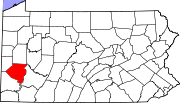Bruceton, Pennsylvania
Bruceton, Pennsylvania | |
|---|---|
Unincorporated community | |
 Dedication of the Experimental Mine, 1910 | |
| Coordinates: 40°18′17″N 79°58′53″W / 40.30472°N 79.98139°WCoordinates: 40°18′17″N 79°58′53″W / 40.30472°N 79.98139°W | |
| Country | United States |
| State | Pennsylvania |
| County | Allegheny County |
| Borough/Township | Jefferson Hills, South Park |
| Elevation | 961 ft (293 m) |
| Time zone | UTC-5 (EST) |
| • Summer (DST) | UTC-4 (EDT) |
Bruceton is an unincorporated suburb of Pittsburgh within Allegheny County, Pennsylvania, United States.[1] Its western half is part of South Park Township, while its eastern half is part of Jefferson Hills.
It is the home of the Experimental Mine of the U.S. Bureau of Mines, which originally opened in 1910.[2][3] It is also the home of the Pittsburgh Safety and Health Technology Center. The Pittsburgh and West Virginia Railway connected to the B&O Railroad in Bruceton.It is 185 mi (or 298 km) northwest of Washington D.C.[4]
History[]
For years in the early 1940s the town hosted almost 100 scientists to help develop the Manhattan Project as a laboratory of the National Defense Research Committee including a month-long visit by Linus Pauling.[5][6][7]
See also[]
- Bruceton analysis
- Experimental Mine, U.S. Bureau of Mines
- George Kistiakowsky
- National Energy Technology Laboratory
- RDX
References[]
- ^ "Bruceton, Pennsylvania". Geographic Names Information System. United States Geological Survey.
- ^ "About NETL". Retrieved 2008-11-15.
- ^ Clements, M.E. (1927). "Uncle Sam's Toy Coal Mine". Popular Science (July): 36. Archived from the original on 2011-06-04. Retrieved 2010-03-07.
- ^ "Bruceton Destination Guide (Pennsylvania, United States) - Trip-Suggest". trip-suggest.com. Retrieved 2020-04-20.
- ^ http://osulibrary.oregonstate.edu/specialcollections/coll/pauling/war/narrative/page28.html
- ^ Lillian Hoddeson; Paul W. Henriksen; Roger A. Meade; Catherine L. Westfall (12 February 2004). Critical Assembly: A Technical History of Los Alamos During the Oppenheimer Years, 1943-1945. Cambridge University Press. pp. 166–. ISBN 978-0-521-54117-6.
- ^ Peter Galison; Bruce William Hevly (1992). Big Science: The Growth of Large-scale Research. Stanford University Press. pp. 270–. ISBN 978-0-8047-1879-0.
- Unincorporated communities in Allegheny County, Pennsylvania
- Unincorporated communities in Pennsylvania
- Allegheny County, Pennsylvania geography stubs


